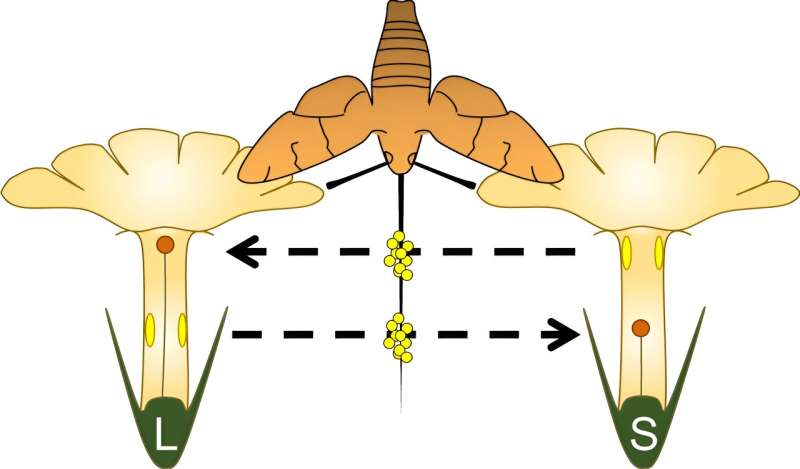This article has been reviewed according to Science X's editorial process and policies. Editors have highlighted the following attributes while ensuring the content's credibility:
fact-checked
peer-reviewed publication
trusted source
proofread
Botanists analyze the role of pollinators in the evolution of flowers with various sexual forms

Researchers Violeta Simón, Marcial Escudero and Juan Arroyo, from the Department of Botany at the Faculty of Biology of the University of Seville, in collaboration with researchers from four other countries, led a study in which they demonstrate Darwin's hypothesis of precise pollination across all angiosperms (flowering plants). The research is published in the journal Nature Communications.
In heterostylous species, there are two (sometimes three) types of flowers, called morphs, which differ according to the location of their sexual organs. The L-morph has the stigma (female sex organs) higher and the anthers (male sex organs) below. And in the S-morph they are the other way around. Darwin proposed that this system evolved to promote cross-pollination (between different individuals, to increase the vigor of their progeny) through a mechanism of precise pollination between the male and female sex organs of each morph, on different parts of the pollinator's body.
This hypothesis of precise pollination hinges on the presence of floral traits and pollinators that fit together like a jigsaw puzzle, so that pollen is accurately deposited and transferred.
"We conducted a comprehensive review of the presence of heterostyly in all angiosperm genera and found many more cases than had been reported in recent literature reviews on the subject. We then collected more than 10,000 data about floral morphology and pollinators across many heterostylous and non-heterostylous species, and placed these data into a mega-phylogeny of all angiosperms to find whether the evolution of heterostyly is associated with floral traits and pollinators that promote precise pollination," explains researcher Violeta Simón.
By looking at the correlations between heterostyly, floral traits and pollinators, the researchers found that heterostyly does indeed evolve in flower lineages with a narrow floral tube and long proboscis pollinators such as butterflies and moths. These pieces fit together to allow pollen to be transferred precisely from one morph to another, as Darwin predicted.
"Heterostyly has been used as a model for studies of floral evolution since Darwin's time, but such an ambitious study on a macroevolutionary scale has never before been undertaken. We believe it will be a seminal work for many researchers in this field," says the researcher Simón. It is worth stressing that this research group has been studying this plant reproductive mechanism for almost 30 years, and is a leader in the role of ecology in its evolution.
More information: Violeta Simón-Porcar et al, Convergent evolutionary patterns of heterostyly across angiosperms support the pollination-precision hypothesis, Nature Communications (2024). DOI: 10.1038/s41467-024-45118-0
Journal information: Nature Communications
Provided by University of Seville




















